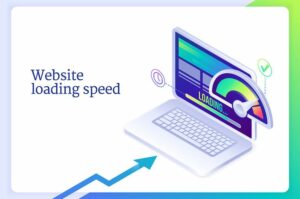Why Website Speed Matters in 2025
In today’s fast-paced digital world, website speed isn’t just a nice-to-have, it’s a critical factor in your website’s success. A slow website kills conversions, frustrates users, and undermines your SEO efforts. Whether you’re running an eCommerce site, a digital portfolio, or a business homepage, speed directly influences how users interact with your brand.

According to studies, even a 1-second delay in page load time can lead to a 7% drop in conversions. If your website loads slowly, users are far more likely to bounce and look elsewhere. Google has also made website speed a core web vital and ranking factor, which means that a sluggish site won’t just hurt user experience — it will also bury your pages in search results.
This guide explores the most common reasons behind a slow website and shows you practical ways to fix them, so your site loads faster, ranks higher, and converts better.
What Slows Down a Website (And How to Fix It)
1. Bloated Themes and Overloaded Plugins
Problem: Heavy themes and excessive plugins slow down your website by loading unnecessary scripts and assets.
Fix:
Choose lightweight themes like Astra, GeneratePress, or Neve.
Audit your plugin list regularly — deactivate or remove unused ones.
Replace bulky builders (like Elementor) with faster alternatives such as Gutenberg or Bricks Builder.
2. Unoptimized Images
Problem: Large, high-resolution images without compression drastically affect website speed.
Fix:
Convert images to modern formats like WebP.
Use image optimization tools such as TinyPNG, Squoosh, or plugins like ShortPixel and Imagify.
Define image dimensions in your HTML or CSS to improve layout rendering speed.
3. No Caching Mechanism
Problem: Every page request is processed from scratch, leading to delays and a slow website experience.
Fix:
Implement server-side caching like LiteSpeed, Redis, or Varnish.
Use WordPress caching plugins such as WP Rocket, LiteSpeed Cache, or W3 Total Cache.
Enable Object Cache and Browser Cache to speed up repeat visits.
4. Poor Hosting Infrastructure
Problem: Shared hosting environments often lack the resources needed to handle moderate to high traffic.
Fix:
Upgrade to cloud hosting or a dedicated VPS with NVMe storage.
Choose a host that offers modern technologies like PHP 8.x, OPCache, and PHP-FPM.
Monitor Time To First Byte (TTFB); if it’s consistently high, consider migrating to a faster host.
5. Render-Blocking JavaScript and CSS
Problem: External scripts delay the browser’s ability to load and render content.
Fix:
Defer or load non-critical JavaScript asynchronously.
Minify and combine CSS and JS files using plugins like Autoptimize or Asset CleanUp.
Inline critical CSS to allow faster above-the-fold rendering.
6. No CDN (Content Delivery Network)
Problem: Users located far from your server face latency and slow website speed.
Fix:
Use free or affordable CDNs like Cloudflare, Bunny.net, or StackPath.
Deliver static assets (images, JS, CSS) from edge servers closer to your users.
Combine CDN usage with caching for maximum performance gains.
7. Database Bottlenecks
Problem: A bloated or unoptimized database can slow down dynamic queries and page generation.
Fix:
Clean up your database with plugins like WP-Optimize or Advanced Database Cleaner.
Remove post revisions, spam comments, transients, and overhead.
Use phpMyAdmin to manually optimize tables, and consider a managed database if traffic grows.
8. Too Many HTTP Requests
Problem: Each asset (images, fonts, scripts) adds to load time, especially if not optimized.
Fix:
Combine CSS and JS files when possible.
Use SVGs or image sprites to reduce requests.
Eliminate unused fonts, icons, or libraries.
9. Compression Not Enabled
Problem: Uncompressed files increase page size, slowing down delivery.
Fix:
Enable GZIP or Brotli compression via
.htaccess, cPanel, or hosting dashboard.Most caching plugins provide built-in compression support.
10. External Scripts (Ads, Fonts, Analytics)
Problem: Third-party scripts often load from external domains, slowing down website speed.
Fix:
Self-host Google Fonts or limit font weights/styles.
Defer non-critical analytics scripts.
Avoid embedding unnecessary widgets like chat popups unless essential.
Performance Testing Tools
Before and after making changes, test your website speed with these trusted tools:
Google PageSpeed Insights – Great for understanding Core Web Vitals.
GTmetrix – Offers detailed waterfall analysis and performance scores.
WebPageTest – Ideal for advanced diagnostics like TTFB and CDN effectiveness.
Pingdom Tools – Provides an easy-to-understand performance grade with historical tracking.
Track metrics like TTFB (Time to First Byte), LCP (Largest Contentful Paint), CLS (Cumulative Layout Shift), and number of requests to measure real progress.
Pro Tips for Developers and Power Users
Enable lazy loading for images and iframes using the
loading="lazy"attribute.Limit redirects, especially on landing pages.
Audit your site with Chrome DevTools — the Network tab reveals load bottlenecks.
Use SecurityHeaders.com and Lighthouse Audits to balance speed and security.
Consider implementing server-level performance rules and firewall protection.
Continuous Optimization: The Path to Long-Term Success

Website speed isn’t something you fix once and forget. It’s an ongoing process that demands regular auditing, smart hosting decisions, and clean development practices.
Start with the basics:
Compress and resize images.
Install a caching plugin.
Use a CDN and enable compression.
Then level up:
Fine-tune JavaScript loading.
Optimize your database structure.
Invest in performance-first cloud hosting.
Final Thoughts: Fast is the New Normal
In 2025, users expect websites to be lightning-fast. A slow website isn’t just inconvenient — it’s a liability. It drives away users, hurts your search rankings, and limits your revenue potential.
By proactively managing your website speed, you’re not just improving load times. You’re creating a smoother user experience, building trust, and ultimately increasing your ROI.
So don’t let slow website performance drag your business down. Optimize today, and keep your digital presence lean, mean, and lightning-fast.